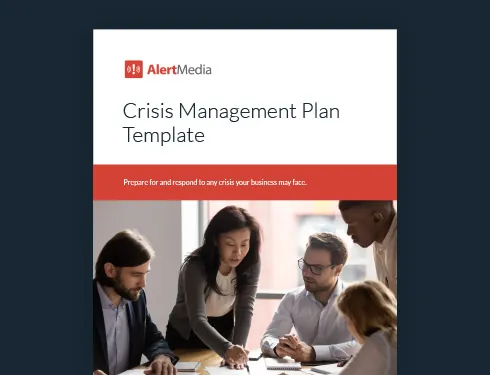
Critical Event Management in a New Era of Safety Threats
Keeping everyone safe and maintaining business continuity requires careful planning and consideration. Learn how to accomplish your safety goals through critical event management.

When we think of business safety emergencies, we tend to imagine the things we’re familiar with—“common” emergencies like trips or slips, inclement weather, and power outages. While those all deserve your attention, it’s also crucial to prepare for the hazards and threats you’re not expecting.
A new era of safety threats
Today’s threats aren’t the same ones our grandparents thought of. For example, over the past few years, we’ve witnessed a new era of conflict emerge entirely over the internet. Countries and non-state actors have increasingly targeted the digital assets of both public and private organizations, ranging from power plants to hospitals to entertainment companies.
Download Our Crisis Management Plan Template

For example, Brian Harrell, former Assistant Secretary for the Department of Homeland Security, has stressed the importance of converged security when it comes to critical event management. Such events as the shelling of the Zaporizhzhia Nuclear Power Plant in Ukraine have demonstrated that physical and technological threats come together in unpredictable ways that are hard to counter.
And we don’t have time to dawdle. Craig Fugate, the former head of FEMA, has pointed out that we are already on the clock when it comes to preparing for climate change: “…the most immediate thing to understand is that climate has already changed. It’s not something that’s ten years down the road.” We are already seeing natural disasters increase in frequency and severity as a result of human-influenced climate change.
A new generation of threats won’t spare any industry, and it’s paramount that safety leaders adapt to the new reality. But that’s no reason to throw up your arms in frustration; let’s look at how your organization can prepare for and react to any and all critical events.
What Is a Critical Event?
Critical events, also known as critical incidents, refer to unforeseen incidents that pose a significant threat to the well-being of a business, its employees, and its ability to continue business operations. These events can occur suddenly without warning and can have devastating consequences if not adequately addressed. Examples of critical events include:
- Natural disasters such as hurricanes, earthquakes, and wildfires
- Terrorism or civil unrest
- Cyberattacks and data breaches
- Workplace violence and active shooter incidents
- Supply chain disruptions
- Workforce shortages
- Industrial accidents
- Pandemics and public health emergencies
Critical events can also range in severity. For example, a supply disruption could be a critical event even if it’s routine since it has the potential to seriously impact your business, and maintaining business continuity should be one of your primary goals.
Preparing for critical events
Businesses must prepare for critical events due to the potentially severe impact they can have on operations. By proactively planning and implementing mitigation strategies for every stage of a crisis, businesses can significantly reduce the potential risks and consequences associated with these events. Some key reasons why businesses should prioritize critical event preparedness include:
- Protecting people and assets: The safety and well-being of employees and customers should always be a top priority and is the primary responsibility of business continuity/disaster recovery teams. A comprehensive emergency response plan can help safeguard lives, reduce injuries, and protect business assets.
- Ensuring business continuity: Critical events can disrupt normal operations, leading to significant financial losses and reputational damage. By preparing for potential disruptions, businesses can enhance their ability to continue essential functions and minimize downtime.
- Compliance and legal requirements: Many industries have specific regulatory requirements regarding business continuity and emergency preparedness. Adhering to these requirements helps businesses maintain compliance and avoid potential penalties or legal issues.
The costs of critical events
The costs associated with critical events can be substantial, impacting businesses both financially and operationally. Businesses that experience a critical event without proper preparedness may face significant costs related to property damage, inventory loss, business interruption, and increased insurance premiums. According to a report by the Ponemon Institute, the average cost of a data breach in 2020 was $3.86 million. The same report found that it takes an average of 280 days to identify and contain a breach. The costs of natural disasters can also be significant, with the National Oceanic and Atmospheric Administration reporting that the U.S. faced 22 weather and climate disasters in 2020, resulting in $95 billion in damages.
Poor handling of a critical event can also damage a company’s reputation, leading to loss of customers, partners, and investor confidence. And if that wasn’t enough, failure to adequately prepare for and respond to critical events can result in legal liabilities, fines, and lawsuits. This is particularly relevant in industries with strict safety regulations or sensitive customer data.
5 Essential Elements of a Critical Event Preparedness Plan
Developing a comprehensive critical event preparedness plan involves several essential elements. By following these steps, businesses can enhance their ability to effectively respond to and recover from critical events:
- Risk assessment: Conduct a thorough business threat assessment to identify potential risks and vulnerabilities specific to your business and its location. Consider both internal and external factors that could impact your operations and ways to mitigate risk.
- Mitigation strategies: Develop strategies to mitigate identified risks, including implementing preventive measures, improving infrastructure resilience, and establishing backup systems and redundancies.
- Emergency response and communication: Establish clear protocols and procedures for responding to critical events. Define roles and responsibilities, create crisis response teams, and establish communication channels to ensure rapid and effective coordination among responders.
- Employee training and communication: Regularly train employees on emergency procedures, emergency evacuation plans, and crisis communication protocols. Ensure everyone is familiar with their roles and responsibilities during critical events. Tabletop exercises are a great, inexpensive way to train this.
- Business continuity planning: Develop a robust business continuity plan to enable essential functions to continue during and after a critical event. Identify critical processes, establish alternative work arrangements, and establish relationships with suppliers and partners.
AlertMedia customers often express the importance of multi-channel communication during critical events: With multiple channels at your disposal, you’re far more likely to reach your audience on whatever device they’re using.
Best Practices for Critical Event Management
To effectively manage critical events, businesses should adopt the following best practices:
- Crisis management framework: Establish a well-defined emergency response framework that outlines the steps to be taken during a critical event. This framework should include incident assessment, decision-making processes, communication plans, and recovery strategies. Stakeholder Communication: Develop comprehensive communication strategies for both internal and external stakeholders. Transparent and timely communication is crucial to managing the impact of a critical event and maintaining stakeholder trust.
- Successful crisis management examples: Highlight successful cases of crisis management in various industries, showcasing organizations that effectively navigated critical events and mitigated their impact. These examples can provide valuable insights and inspiration for businesses in their preparedness efforts.
- Leveraging technology: Utilize threat intelligence and communication technologies to support critical event management. This can include real-time monitoring systems, automated alerts, emergency mass notification systems, collaboration tools, and social media monitoring to enhance situational awareness and facilitate communication.
Critical Success
Preparing for critical events is essential for businesses of all sizes and industries. By understanding the potential risks, investing in comprehensive preparedness plans, and adopting best practices for crisis management, businesses can minimize the impact of critical events on their people, assets, and operations. Don’t wait for a crisis to strike—you have to be proactive to protect your business from all hazards and ensure its long-term success. Start developing your critical event preparedness plan today and equip your organization with the tools and strategies to face any challenge that may arise.

![11 Steps to Creating an Effective Emergency Response Plan [+ Template]](https://www.alertmedia.com/wp-content/uploads/2023/10/Blog-Emergency-Response-Plan.webp)


